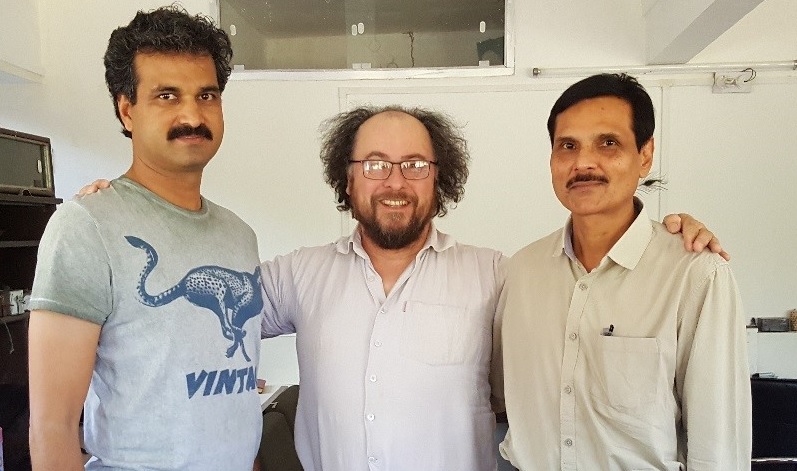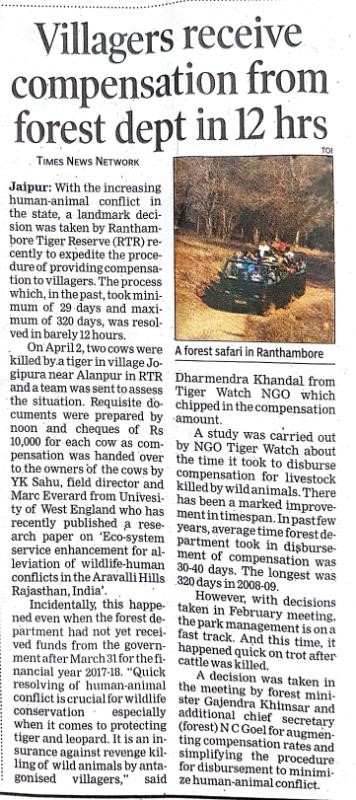
well connected habitats. (Image © Dr Mark Everard)
The blogpost Community-based regeneration in semi-arid north Rajasthan, India (23 November 2015) was the first in a series covering my work under the IWSN about efforts to reanimate socio-ecological landscapes in semi-arid Rajasthan, India. This is part of an expanding programme working with local people and institutions in Rajasthan, much of it now addressing the Banas River.
The Banas River runs for approximately 500km eastwards across the semi-arid landscape, joining the Chambal River which in turn runs into the Yamuna and subsequently the Ganga system. A lower reach of the Banas runs through Amlidha region, location of several villages and a buffer zone of the Ranthambhore Tiger Reserve. Amlidha is a corridor for tigers and also leopards, other wild cat and dog species, porcupines, sloth bears and various ungulates regularly captured on camera traps moving through the villages and environs.

Watch offices to progress human-wildlife conflict and other water-
related conservation work. (Image © Dr Mark Everard)
After long-term decline, Bengal Tiger numbers are now increasing in response to concerted conservation efforts. These animals are territorial, so buffer zones for dispersal between core zones of tiger reserves, and now increasingly between reserves, are critically important. But as people live in this zone and have predominantly agricultural livelihoods – arable and herding of goats and buffalo – there is potential for increasing conflict. This is exacerbated by now extensive flattening of formerly complex and biodiverse riparian ravine habitat for arable production. With less habitat useful for cover, unimpeded movement and small prey, risks of human-wildlife conflict are increasing.

Department compensation payments to animal owners and
publication of our scientific paper (click to enlarge)
In late March 2017, the paper Ecosystem service enhancement for the alleviation of wildlife-human conflicts in the Aravalli Hills, Rajasthan, India was published in the journal Ecosystem Services, addressing the potential of working with people to electively zone the landscape to create ‘blue-green corridors’ such that land uses retain landscape permeability for terrestrial (green corridors) and aquatic (blue corridor) animal movement. Avoidance of conflict is a primary win-win benefit. This will be founded on using local knowledge and community governance institutions to decide where land uses can allow simultaneously for food production and habitat for wildlife.
I co-authored the paper with Dr Dharmendra Khandal (Tiger Watch, and India’s prime tiger expert) and Yogesh Sahu (Field Director of the Ranthambhore Tiger Reserve, Rajasthan Forestry Department). In April 2017, we met to follow up how to turn this proposal into action. Tiger Watch and Rajasthan Forestry Department will progress these ideas, and we are also collaborating on other water-related ecosystem service programmes on which I will report in subsequent blogposts.
On the evening of 2 April 2017, the day before our first meeting, two cows were killed by a tiger in the village of Jogipura, adjacent to the park. One of many schemes in place to engage locals in the benefits of the park and to placate them after conflict is a compensation scheme for killed stock animals. Formerly, this had been a protracted affair, not ideal for placating local people. Mr Sahu had just instituted a new verification and processing system that shortened the process substantially, in this case to just 12 hours. As the newspaper clipping (right) shows, I was invited as a VIP to help give cheques to the two affected farmers, reflecting the increasing collaboration and impact of IWSN/UWE with socio-ecological management in and adjacent to Ranthambhore Tiger Reserve.
